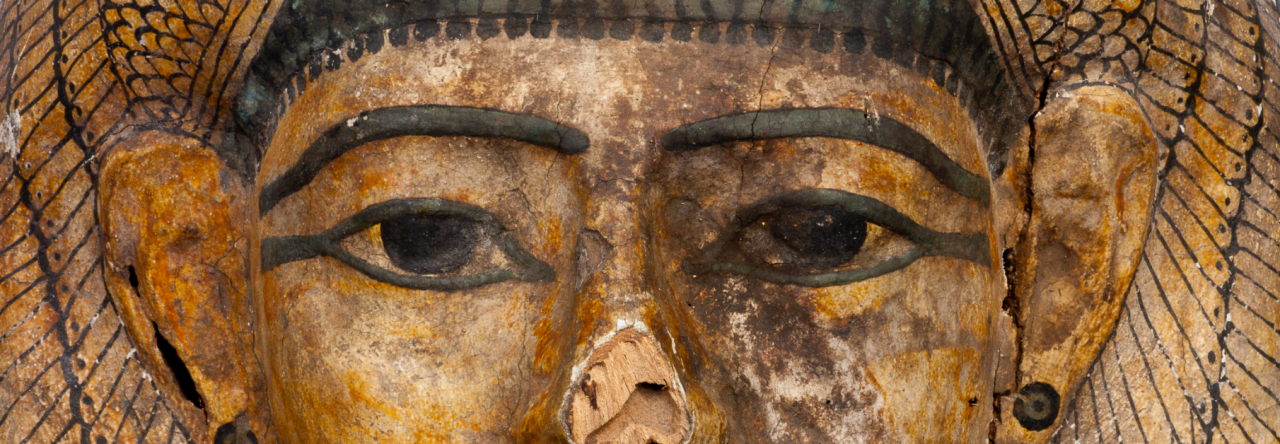From the University of Richmond Museums 2012 Exhibition,
Ti Ameny Net: An Ancient Mummy, An Egyptian Woman, and Modern Science.
——————————
The exhibition celebrates the life of Ti-Ameny-Net, a woman who lived in Egypt in the 7th century BCE and whose mummy was donated to Richmond College in 1876 by Professor Jabez L. M. Curry. This exhibition features the mummy of Ti-Ameny-Net, her elaborately decorated wooden coffin, and a selection of Egyptian artifacts from the collections of the Stuart L. Wheeler Gallery of the Ancient World, Department of Classical Civilization, University of Richmond, and the Lora Robins Gallery of Design from Nature, University of Richmond Museums.
About the Exhibition
Also on view are images and information based on modern scientific studies of the mummy conducted by University of Richmond undergraduate, Caroline Cobert, ’12, biology and classical civilization double major. The results of the studies are presented in the exhibition, along with some of the tools used in the scientific analyses and the three-dimensional CT (computerized tomography) images from Virginia Commonwealth University Medical Center. Also displayed is a comparison of the x-rays of Ti-Ameny-Net from the 1970s and from 2009, to demonstrate how the contribution of recent modern medicine has enhanced the study of the ancient dead.
Ti-Ameny-Net was buried on the west coast of the Nile, near the Valley of the Kings and probably lived in Thebes. Her mummy was one of thirty excavated at Thebes as entertainment for the Prince of Wales, Edward VII, who was visiting the region in 1869. The Prince gave Ti-Ameny-Net’s body and coffin to his American translator, who sold the mummy in 1875 to Dr. Jabez L. M. Curry, Professor of English and Richmond College Trustee. Dr. Curry donated the mummy and coffin to the newly-founded Richmond College Museum, after an initial exhibition at the Philadelphia World’s Fair in 1876. She arrived in Richmond to great fanfare and was displayed first in the Richmond College Museum, then in Jeter Memorial Hall Library. When the college relocated in 1914 to the campus located in the west end of Richmond, Ti-Ameny-Net was displayed in the library and then housed in the Biology department before finally coming to rest in the Ancient World Gallery of the Department of Classical Studies, founded by Stuart L. Wheeler in 1979.
Recent scientific analysis has shed new light on this ancient woman’s life. In 2009, student Caroline Cobert undertook a scientific study of Ti-Ameny-Net. Virginia Commonwealth University Medical Center agreed to provide new CT-scans and x-rays and to extract a DNA sample under the guidance of Dr. Ann Fulcher, a 1983 graduate of University of Richmond and Professor and Chair of the Department of Radiology, VCU Medical Center. At the University of Richmond biology labs, Cobert tested for various genes to prove that the sample was genuinely Ti-Ameny-Net’s, then tested for traces of the pathogens that cause malaria and tuberculosis. The CT-scans and x-rays were analyzed for evidence of Ti-Ameny-Net’s health, including any trauma, chronic illness, or any clues as to what might have ended her life.
These studies reveal that she was around 30 years old when she died and that she suffered from degenerative scoliosis. She had a good diet and no sign of tuberculosis or malaria, but very worn teeth, a common problem in ancient Egypt. The overall good condition of her bones confirm the impression given by the evident care with which she was mummified and by the decoration of her coffin, that she was a member of the elite class. On-going analysis aims to determine a cause of death.
Before these scientific studies, the bulk of information about Ti-Ameny-Net’s life came from her painted wooden coffin, covered in hieroglyphic writing and religious imagery. One part of the hieroglyphic text provides the names of her parents, Nesy-Amun and Ruru or Lulu, and addresses Ti-Ameny-Net as “mistress of the house,” a common epithet for high-ranking women in ancient Egypt. The text also contains prayers for the deceased, dedicated by funerary gods such as Osiris and the four sons of Horus. The head of the mummiform coffin is painted with an elaborate vulture headdress over a thick black wig, and a multicolored, wide collar around the neck. In the coffin interior stands a full-length representation of the goddess Nut with arms outstretched to embrace the deceased. Nut, the sky goddess, is considered one of the oldest deities among the Egyptian pantheon.
Selections from the collections of the University of Richmond’s Stuart L. Wheeler Gallery of the Ancient World and the Lora Robins Gallery of Design from Nature highlight the complex and pervasive nature of Egyptian funerary beliefs, those that Ti-Ameny-Net herself likely held. An alabaster canopic jar would have been used to store the embalmed organs of the deceased. Small faience shabti figures were symbolic representations of the servants the deceased would have needed in the afterlife.
This exhibition was organized by the University of Richmond Museums and curated by Caroline Cobert, ’12, Biology and Classical Civilization double major, with Elizabeth Baughan, Assistant Professor of Classics and Archaeology, University of Richmond, and N. Elizabeth Schlatter, Deputy Director and Curator of Exhibitions, University Museums.
The Exhibition
The Life and Death of Ti Ameny Net
Iconography and Hieroglyphs
The Science
Credit and Ethics
Educational Materials
Follow these links to the University of Richmond Museums’ materials related to Ti Ameny Net: An Ancient Mummy, An Egyptian Woman, and Modern Science
– Pre-visit Mummy PowerPoint (downloads to your desktop)
